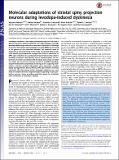Molecular adaptations of striatal spiny projection neurons during levodopa-induced dyskinesia
Author(s)
Heiman, Myriam; Heilbut, Adrian; Francardo, Veronica; Kulicke, Ruth; Fenster, Robert; Kolaczyk, Eric D.; Mesirov, Jill P.; Surmeier, Dalton J.; Cenci, M. Angela; Greengard, Paul; ... Show more Show less
DownloadHeiman-2014-Molecular adaptation.pdf (1.041Mb)
PUBLISHER_POLICY
Publisher Policy
Article is made available in accordance with the publisher's policy and may be subject to US copyright law. Please refer to the publisher's site for terms of use.
Terms of use
Metadata
Show full item recordAbstract
Levodopa treatment is the major pharmacotherapy for Parkinson's disease. However, almost all patients receiving levodopa eventually develop debilitating involuntary movements (dyskinesia). Although it is known that striatal spiny projection neurons (SPNs) are involved in the genesis of this movement disorder, the molecular basis of dyskinesia is not understood. In this study, we identify distinct cell-type–specific gene-expression changes that occur in subclasses of SPNs upon induction of a parkinsonian lesion followed by chronic levodopa treatment. We identify several hundred genes, the expression of which is correlated with levodopa dose, many of which are under the control of activator protein-1 and ERK signaling. Despite homeostatic adaptations involving several signaling modulators, activator protein-1–dependent gene expression remains highly dysregulated in direct pathway SPNs upon chronic levodopa treatment. We also discuss which molecular pathways are most likely to dampen abnormal dopaminoceptive signaling in spiny projection neurons, hence providing potential targets for antidyskinetic treatments in Parkinson's disease.
Date issued
2014-03Department
Massachusetts Institute of Technology. Department of Brain and Cognitive Sciences; Picower Institute for Learning and MemoryJournal
Proceedings of the National Academy of Sciences
Publisher
National Academy of Sciences (U.S.)
Citation
Heiman, M., A. Heilbut, V. Francardo, R. Kulicke, R. J. Fenster, E. D. Kolaczyk, J. P. Mesirov, D. J. Surmeier, M. A. Cenci, and P. Greengard. “Molecular Adaptations of Striatal Spiny Projection Neurons During Levodopa-Induced Dyskinesia.” Proceedings of the National Academy of Sciences 111, no. 12 (March 5, 2014): 4578–4583.
Version: Final published version
ISSN
0027-8424
1091-6490